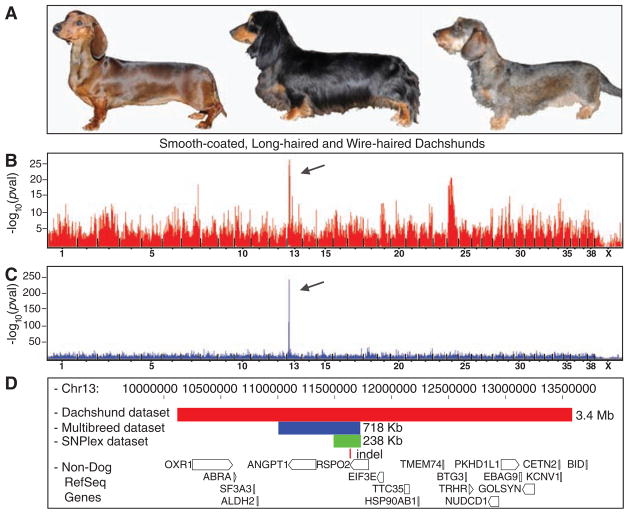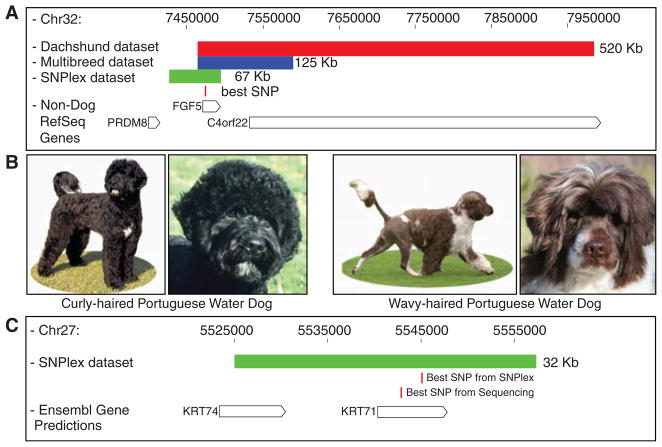Introduction
Increasingly, biological researchers are discovering the interactive genetic effects that underlie complex phenotypic traits. Dog coat variation is one such complex trait, and recently, in research published in the journal Science, Cadieu et al. (2009) reported on mutations responsible for a wide range of fur types found in domestic dogs. Specifically, they researched the genes regulating three coat features: furnishings (presence of moustache and eyebrows), hair length (short or long), and curl (presence or absence of curl).
Generally, the same experimental procedure was used to identify the gene responsible for each of the three coat phenotypes. First, the researchers used single-nucleotide polymorphism (SNP) datasets for a single dog breed to identify regions of the dog genome associated with a particular phenotypic feature (commonly called genome-wide association studies). To confirm results obtained through study of a single breed, they searched a larger SNP database, CanMap, which contained information from 903 dogs representing 80 different breeds. Then, fine scale mapping was employed to locate the smallest haplotype (combination of SNP alleles inherited together) that were associated with the phenotype. Finally, regions of interest were sequenced directly to identify the genetic changes underlying the fur traits.
Detailed discussion of the research findings will be organized around the paper’s figures:
Figure 1

Researchers began by searching for the gene responsible for coat furnishings (the presence of growth around the moustache and eyebrows). A dachshund SNP database was used in this analysis with smooth-coated and long-haired varieties representing controls (they have no furnishings) and wire-haired dogs as cases (they have furnishings; dachshund phenotypes shown in Fig. 1A). Analysis within this dachshund dataset revealed strong linkage on canine chromosome 13 (Fig. 1B, the linked locus as identified by the best lod score is indicated with an arrow; associated haplotype region indicated by the red rectangle in Fig. 1D), and the CanMap database revealed linkage within the same region (Fig. 1C; associated haplotype region indicated by the blue rectangle in Fig. 1D). Fine mapping narrowed the search to a 238 kb region (Fig. 1D, green rectangle) that overlapped with only one gene, RSPO2, which encodes R-spondin-2. This gene likely contributes to hair furnishings because of its interactions with another gene,Wnt, that is involved in the establishment of hair follicles. Interestingly, the mutation identified in RSPO2 was not located in the coding region of the gene, but was found to be a 167 bp insertion event in the gene's 3’ untranslated region (UTR; shown in Fig. 1D as the small red line labeled "indel"). While the insertion event does not result in changes to the R-spondin-2 protein sequence, the researchers found that changes to the 3’ UTR affect mRNA stability, and dogs with furnishings showed a threefold increase in RSPO2 transcript expression relative to controls. Dogs that were either homozygous or heterozygous for the 3’ UTR insertion event were found to have furnishings, indicating a dominant mode of inheritance for this trait.
Figure 2

When the researchers began mapping the gene that controls hair length, they already had a candidate gene in mind because FGF5 (the gene encoding fibroblast growth factor-5) is known to contribute to hair growth in some Welsh corgis, mice, and cats. As expected, SNP analysis of both dachshunds and the CanMap dataset revealed strong association with a region on canine chromosome 32 containing FGF5 (Fig. 2A; red, blue, and green rectangles represent associated haplotypes obtained from dachshund, CanMap, and fine mapping analyses, respectively). Sequencing revealed that the point mutation in question (G to T) resulted in a single amino acid change (Cys to Phe) in exon 1 of the gene (this mutation is shown as the small red line labeled "best SNP" in Fig. 2A). Only dogs that were homozygous for the mutant allele showed the long hair phenotype, indicating a recessive mode of inheritance for this trait. However, the authors also note that at least three dog breeds have long hair but do not harbor the Cys to Phe mutation or show linkage with canine chromosome 32, indicating that other loci regulating hair length exist within the dog genome.
Finally, to map the curly fur phenotype, the researchers used a Portuguese Water Dog SNP database, with curly-haired dogs as the cases and wavy-haired dogs as the controls (phenotypes shown in Fig. 2B). They identified a linkage region on canine chromosome 27 that overlapped with two keratin genes (Fig. 2C; haplotype identified through fine mapping indicated with the green rectangle). Through sequencing, the team found a nonsynonymous Arg to Trp alteration in the keratin-71 gene, KRT71. Keratins are well-known structural proteins found in both hair and nails, and the researchers suspect that this alteration to the second exon of KRT71 may result in altered protein folding or cellular localization, changes which ultimately manifests themselves as the curly-haired phenotype.
Figure 3

When considered in combination, these three mutations are able to explain 95% of the variation seen in fur phenotype among the dogs sampled. Analysis of wolves and short-haired dogs revealed that they harbored none of the three mutations found, indicating that short-haired dogs without furnishings or curl represent the ancestral coat phenotype for dogs (ancestral genotype conditions are indicated by “-“ signs in the boxes within Fig. 3). Different combinations of FGF5, RSPO2, and KRT71 mutations result in the appearance of 6 unique dog coat phenotypes. Figure 3 shows the mutation combinations that result in the different coat varieties (rows A-G; “+” signs indicate the presence of the mutant genotype for a particular gene) with dogs representative of each phenotype shown to the right of the table.
Conclusions
Overall, this paper provides a straightforward genetic explanation for much of the coat variation we see in domestic dogs today. It clearly demonstrates that phenotypic diversity may be generated through the interactive effects of relatively few genes. In the case of all three phenotypic characteristics studied (furnishings, hair length, and curl), small genetic changes (insertions or point mutations) have the potential to result in drastic phenotypic changes, suggesting that at least some genes may be able to generate novel phenotypes over short evolutionary time spans. In fact, I was surprised the authors found that each of the traits studied were ultimately the result of only one mutation in one gene. I would have expected that even the basic traits studied (i.e., furnishings, hair length, and curl) would themselves each be the result of a number of interacting gene effects. This may, in fact, be the case if more dog breeds are considered because the authors acknowledge that some breeds show long-haired phenotypes that are not a result of the mutation described within the paper, suggesting that this trait is regulated at multiple loci. Furthermore, while the authors' data are able to explain a large proportion (95%) of the phenotypic variability in the dataset they studied, they only considered 108 out of the approximately 160 officially recognized dog breeds. We might expect that coat variation in some of the breeds that were not studied is the result of novel mutations not described within this paper. Nonetheless, I was impressed that Cadieu et al. were able to use genomic data on a variety of breeds to demonstrate the genetic basis for what may initially seem to be a daunting phenotype to characterize at the molecular level.
References
Cadieu, E, Neff, MW, Quignon, P, Walsh, K, Chase, K, Parker, HG, VonHoldt, BM, Rhue, A, Boyko, A, Byers, A, Wong, A, Mosher, DS, Elkahloun, AG, Spady, TC, André, C, Lark, KG, Cargill, M, Bustamante, CD, Wayne, RK, and Ostrander, EA. 2009. Coat variation in the domestic dog is governed by variants in three genes. Science 326: 150-153.